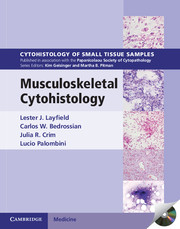24 results
16 - Fine-Needle Aspiration of Soft Tissue and Bone
-
-
- Book:
- Differential Diagnosis in Cytopathology
- Published online:
- 05 March 2021
- Print publication:
- 06 May 2021, pp 506-547
-
- Chapter
- Export citation
Chapter 14 - Neoplastic and tumor-like lesions of bone
-
-
- Book:
- Silverberg's Principles and Practice of Surgical Pathology and Cytopathology
- Published online:
- 13 March 2015
- Print publication:
- 26 March 2015, pp 1008-1124
-
- Chapter
- Export citation
Contributors
-
-
- Book:
- Silverberg's Principles and Practice of Surgical Pathology and Cytopathology
- Published online:
- 13 March 2015
- Print publication:
- 26 March 2015, pp vii-x
-
- Chapter
- Export citation
Contributors
-
-
- Book:
- Differential Diagnosis in Cytopathology
- Published online:
- 05 December 2014
- Print publication:
- 04 December 2014, pp viii-x
-
- Chapter
- Export citation
Chapter 16 - Fine-needle aspiration of soft tissue and bone
-
-
- Book:
- Differential Diagnosis in Cytopathology
- Published online:
- 05 December 2014
- Print publication:
- 04 December 2014, pp 520-565
-
- Chapter
- Export citation
Acknowledgments
-
-
- Book:
- The Zebrafish
- Published online:
- 05 February 2013
- Print publication:
- 21 January 2013, pp viii-viii
-
- Chapter
- Export citation
14 - Cystic lesions of bone and soft tissue
-
- Book:
- Musculoskeletal Cytohistology
- Published online:
- 05 September 2013
- Print publication:
- 01 January 2000, pp 303-313
-
- Chapter
- Export citation
7 - Lipomatous tumors
-
- Book:
- Musculoskeletal Cytohistology
- Published online:
- 05 September 2013
- Print publication:
- 01 January 2000, pp 140-164
-
- Chapter
- Export citation

Musculoskeletal Cytohistology
-
- Published online:
- 05 September 2013
- Print publication:
- 01 January 2000
13 - Epithelioid and polygonal cell tumors of bone and soft tissue
-
- Book:
- Musculoskeletal Cytohistology
- Published online:
- 05 September 2013
- Print publication:
- 01 January 2000, pp 275-302
-
- Chapter
- Export citation
6 - Myxoid lesions of bone and soft tissue
-
- Book:
- Musculoskeletal Cytohistology
- Published online:
- 05 September 2013
- Print publication:
- 01 January 2000, pp 114-139
-
- Chapter
- Export citation
3 - Spindle cell tumors of bone and soft tissue in infants and children
-
- Book:
- Musculoskeletal Cytohistology
- Published online:
- 05 September 2013
- Print publication:
- 01 January 2000, pp 23-40
-
- Chapter
- Export citation
8 - Vascular tumors of bone and soft tissue
-
- Book:
- Musculoskeletal Cytohistology
- Published online:
- 05 September 2013
- Print publication:
- 01 January 2000, pp 165-182
-
- Chapter
- Export citation
11 - Cartilaginous neoplasms of bone and soft tissue
-
- Book:
- Musculoskeletal Cytohistology
- Published online:
- 05 September 2013
- Print publication:
- 01 January 2000, pp 220-246
-
- Chapter
- Export citation
Index
-
- Book:
- Musculoskeletal Cytohistology
- Published online:
- 05 September 2013
- Print publication:
- 01 January 2000, pp 314-319
-
- Chapter
- Export citation
4 - Spindle cell tumors of the musculoskeletal system characteristically occurring in adults
-
- Book:
- Musculoskeletal Cytohistology
- Published online:
- 05 September 2013
- Print publication:
- 01 January 2000, pp 41-91
-
- Chapter
- Export citation
12 - Small round cell neoplasms of bone and soft tissue
-
- Book:
- Musculoskeletal Cytohistology
- Published online:
- 05 September 2013
- Print publication:
- 01 January 2000, pp 247-274
-
- Chapter
- Export citation
1 - Principles and practice for biopsy diagnosis and management of musculoskeletal lesions
-
- Book:
- Musculoskeletal Cytohistology
- Published online:
- 05 September 2013
- Print publication:
- 01 January 2000, pp 1-8
-
- Chapter
- Export citation
10 - Osseous tumors of bone and soft tissue
-
- Book:
- Musculoskeletal Cytohistology
- Published online:
- 05 September 2013
- Print publication:
- 01 January 2000, pp 198-219
-
- Chapter
- Export citation
Frontmatter
-
- Book:
- Musculoskeletal Cytohistology
- Published online:
- 05 September 2013
- Print publication:
- 01 January 2000, pp i-iv
-
- Chapter
- Export citation



